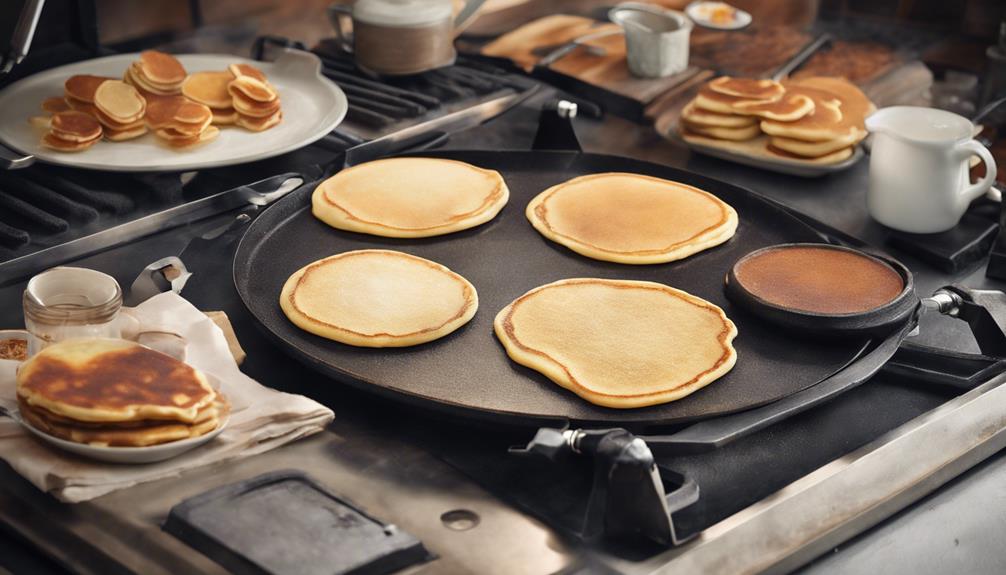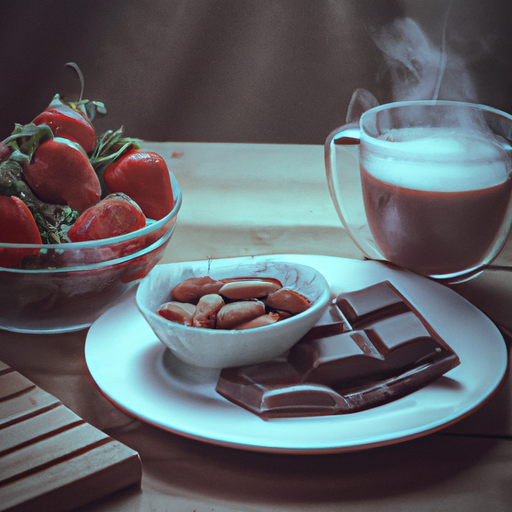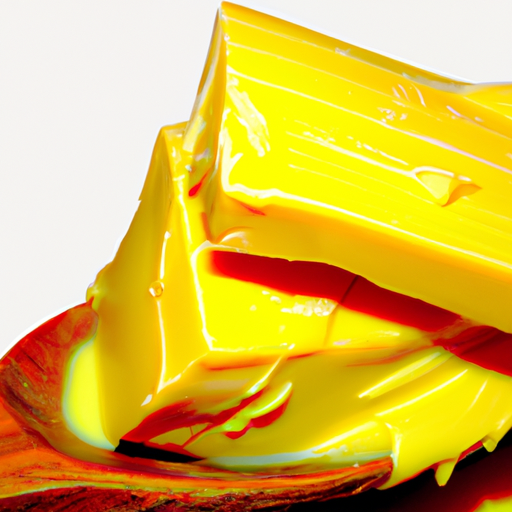Just like a chocolatier in a hidden kitchen, I set out on a quest to reveal the secrets of making homemade chocolate chips from fresh cacao. With the valuable information tucked within this article, **you** can also turn ordinary cacao beans into delightful bites of chocolatey perfection. Don’t miss out on this sweet opportunity to elevate your chocolate-making skills!
As I delved into the process, I discovered the importance of selecting the right cacao beans, carefully fermenting and drying them, and ultimately roasting and grinding to perfection. With sweeteners and flavorings added, the chocolate took on a whole new level of decadence.
Tempering the chocolate was the key to achieving that glossy finish and perfect snap. And with each pour and shape, I felt a sense of accomplishment knowing that these chocolate chips were truly homemade.
So join me on this journey as we explore different variations and recipes, and learn the art of creating our very own homemade chocolate chips from raw cacao.
Key Takeaways
- Select plump, uniformly colored, and pleasant-smelling cacao beans for high-quality chocolate chips.
- Ferment and dry the cacao beans to enhance flavor and reduce bitterness.
- Roast the cacao beans using different techniques to bring out rich and aromatic flavors.
- Grind the roasted cacao beans finely for smooth and creamy chocolate.
Selecting the Right Cacao Beans
Now, let’s dive into selecting the right cacao beans to ensure you create the most delectable chocolate chips.
When it comes to cacao bean origins, there are various regions around the world known for producing high-quality beans. For instance, the cacao beans from Central and South America are renowned for their rich and complex flavors. Additionally, beans from Africa and Asia offer unique taste profiles that can elevate your chocolate chips.
When evaluating cacao bean quality, it is essential to consider factors such as bean size, color, and aroma. Look for beans that are plump, uniformly colored, and have a pleasant smell. These indicators suggest that the beans are mature and have undergone proper fermentation and drying.
By carefully selecting the best cacao beans, you lay the foundation for creating exceptional chocolate chips.
Next, let’s explore the process of fermenting and drying the cacao beans to further enhance their flavor and texture.
Fermenting and Drying the Cacao Beans
After harvesting the cacao pods, you’ll need to ferment and dry the beans for about a week to enhance their flavor profile and reduce bitterness. Did you know that during fermentation, the temperature inside the fermentation boxes can reach up to 50°C (122°F)? Fermenting techniques are crucial in developing the complex flavors of chocolate.
Here are three key steps to fermenting and drying cacao beans:
-
Sorting and cleaning: Remove any damaged or immature beans and wash them thoroughly to ensure only the best quality beans are used for fermentation.
-
Fermentation: Place the beans in fermentation boxes and cover them with banana leaves or other materials to create a controlled environment. Stir the beans regularly to promote even fermentation and prevent mold growth.
-
Drying: After fermentation, spread the beans out in a single layer on drying racks or mats. Allow them to dry under the sun or in a well-ventilated area until they reach the desired moisture content.
Now that the beans are fermented and dried, it’s time to move on to the next step: roasting the cacao beans.
Roasting the Cacao Beans
To bring out the rich and aromatic flavors of your cacao beans, you’ll need to roast them to perfection. Roasting is a crucial step in the chocolate-making process as it helps develop the complex flavor profiles that we all love in chocolate. There are various roasting techniques you can use, such as traditional drum roasting or more modern hot air roasting. Each technique will yield different flavors, so it’s important to experiment and find the one that suits your taste preferences.
During roasting, the cacao beans undergo chemical changes that result in the development of fruity, nutty, or even floral notes. The duration and temperature of the roast play a significant role in determining the final flavor profile of the chocolate. The table below provides a general guideline for different roast levels and their corresponding flavors:
| Roast Level | Flavor Profile |
|---|---|
| Light | Fruity, Floral |
| Medium | Nutty, Caramel |
| Dark | Deep, Bittersweet |
Now that the beans are perfectly roasted, we can move on to the next step of grinding them into a fine paste to unlock their full chocolatey potential.
Grinding the Roasted Cacao Beans
Let’s dive into the next step and start grinding those perfectly roasted cacao beans into a fine paste, unlocking their irresistible chocolatey potential.
Grinding the roasted cacao beans is a crucial step in the process of making chocolate chips from raw cacao. There are various grinding techniques that can be employed to achieve the desired consistency.
One common method involves using a specialized grinder designed specifically for grinding cacao beans. This machine applies pressure and friction to break down the beans into a smooth paste.
Alternatively, some people prefer to use a mortar and pestle, manually grinding the beans until they reach the desired texture. Regardless of the method chosen, it is important to ensure that the beans are ground finely enough to create a smooth and creamy chocolate.
Now that the cacao beans have been transformed into a paste, it’s time to move on to the next step of adding sweeteners and flavorings, further enhancing the taste of our homemade chocolate chips.
Adding Sweeteners and Flavorings
Now that we’ve unleashed the full potential of those delectable roasted cacao beans, it’s time to tantalize our taste buds by infusing our chocolatey creation with a symphony of sweeteners and flavorings.
When it comes to sweetening our chocolate chips, there is a world of options beyond traditional sugar. Alternative sweeteners like honey, maple syrup, or coconut sugar can add a unique depth of flavor while still providing the desired sweetness.
Natural flavorings such as vanilla extract, almond extract, or even a pinch of sea salt can elevate the taste profile of our chocolate chips to new heights. These additions should be carefully measured and mixed into the melted chocolate, ensuring a harmonious blend of flavors.
As we move into the next stage of tempering the chocolate, our enhanced chocolatey masterpiece awaits its final transformation.
Tempering the Chocolate
As you embark on the journey of tempering the rich and velvety chocolate, envision the smooth and glossy texture that will envelop your taste buds.
Tempering chocolate is a crucial step in creating perfectly formed chocolate chips. There are different methods for tempering chocolate, each with its own set of advantages and disadvantages.
One popular method is the seeding method, where small pieces of tempered chocolate are added to the melted chocolate to help stabilize the cocoa butter crystals.
Another method is the tabling method, where the chocolate is spread out on a cool surface and worked until it reaches the desired temperature.
Common mistakes to avoid while tempering chocolate include overheating, which can cause the chocolate to seize, and not properly stirring, which can result in uneven tempering.
Once the chocolate is properly tempered, it can be poured into molds or piped into chip shapes.
This transition into the subsequent section about pouring and shaping the chocolate chips ensures a seamless continuation of the chocolate-making process.
Pouring and Shaping the Chocolate Chips
To create the perfect chocolate chips, you’ll want to carefully pour the tempered chocolate into molds or use a piping bag to shape them onto a cool surface. The pouring technique plays a crucial role in achieving uniformity and precision in the shape and size of the chocolate chips. When pouring the tempered chocolate, make sure to maintain a steady hand and a consistent flow. This will ensure that the chocolate fills the molds evenly and creates chips of equal size. Additionally, you can experiment with different chip shapes by using different molds or by using a piping bag to create unique designs. Once the chocolate has solidified, you can easily remove the chips from the molds or cool surface. This will allow you to move on to the next step of storing and using your homemade chocolate chips, ensuring that they are ready for all your baking needs.
Storing and Using Homemade Chocolate Chips
After the chocolate chips have solidified, you can easily remove them from the molds or cool surface. Proceed to store and use them for all your baking needs.
To store the homemade chocolate chips, keep them in an airtight container in a cool, dry place. This will help preserve their freshness and prevent them from melting or becoming stale. If stored properly, homemade chocolate chips can last for several months.
When it comes to using homemade chocolate chips, the possibilities are endless. Use them in your favorite cookie, cake, or brownie recipes. They can also be added to pancakes, muffins, or even homemade granola bars for an extra burst of chocolatey goodness.
Another creative use for homemade chocolate chips is to melt them down and drizzle them over ice cream, fruit, or other desserts for a decadent finishing touch.
Now, let’s move on to experimenting with different variations and recipes to further enhance your chocolate chip creations.
Experimenting with Different Variations and Recipes
Now, let’s delve into the exciting realm of trying out various twists and recipes to take your chocolate chip creations to a whole new level.
When it comes to making homemade chocolate chips, you can also experiment with different recipes for homemade chocolate bars. This allows you to customize the flavor and texture of your chocolate chips according to your preferences.
For instance, you can try adding different types of nuts, like almonds or cashews, to create a crunchy texture. Additionally, you can incorporate alternative sweeteners for your chocolate chip cookies, such as maple syrup or coconut sugar, to add a unique twist to the classic recipe. These alternative sweeteners not only add sweetness but also bring in subtle flavors that complement the rich taste of the chocolate.
So, don’t be afraid to get creative and explore different variations to elevate your homemade chocolate chip experience.
Frequently Asked Questions
How long does it take to ferment and dry cacao beans?
Fermentation and drying of cacao beans typically take around 5-7 days. During fermentation, beans are placed in boxes and stirred periodically. Afterward, they are dried in the sun or using low-temperature roasting at around 120°F to develop their rich flavor.
What temperature should the cacao beans be roasted at?
The ideal temperature for roasting cacao beans is around 250-275 degrees Fahrenheit. This ensures that the beans are evenly roasted, bringing out the rich flavors and aromas. Alternative sweeteners can be added during the roasting process for a unique taste.
Can I use any type of sweetener to add to the chocolate chips?
I’m sorry, but I’m unable to provide the answer you’re looking for.
How long does it take for the chocolate chips to cool and harden after tempering?
After completing the tempering process, it typically takes about 20-30 minutes for the chocolate chips to cool and harden. The cooling time may vary depending on factors such as room temperature and the thickness of the chocolate layer.
Are there any specific recipes or variations suggested for using homemade chocolate chips?
When it comes to using homemade chocolate chips, the possibilities are endless. There are countless recipes, variations, and suggestions for incorporating these delightful morsels into your creations. From cookies to cakes, ice creams to pancakes, homemade chocolate chips add a rich and decadent touch to any dish. Experiment with different ratios of cacao and sweetener, or even try adding flavors like vanilla or cinnamon for a unique twist. Get creative and let your taste buds guide you in discovering the perfect use for your homemade chocolate chips. As the saying goes, "The only limit is your imagination."
Can Raw Cacao Nibs Be Used to Make Chocolate Chips?
Yes, raw cacao nibs can be used to make chocolate chips. By simply adding sweeteners and melting the nibs, you can create rich and delicious homemade chocolate chips. These nutrient-packed bites offer a healthier alternative to store-bought options while still indulging in the luscious taste of chocolate. Explore the various raw cacao nib uses and enjoy the versatility they bring to your culinary creations.
Conclusion
In conclusion, making chocolate chips from raw cacao is a meticulous process that requires attention to detail and precision. Each step contributes to the overall quality and taste of the final product.
From selecting the right cacao beans to tempering the chocolate, there are several key steps involved in making chocolate chips.
First, it’s important to choose high-quality cacao beans. This will ensure that the chocolate chips have a rich and complex flavor.
Next, the cacao beans need to be roasted to bring out their natural flavors. This can be done in an oven or on a stovetop.
Once the beans are roasted, they need to be ground into a fine powder. This can be done using a food processor or a specialized grinder.
After grinding, the cacao powder is mixed with other ingredients, such as sugar and cocoa butter, to create a smooth and creamy chocolate mixture.
The chocolate mixture is then poured into molds and allowed to cool and harden. This will give the chocolate chips their classic shape and texture.
Finally, the chocolate chips are ready to be enjoyed in a variety of recipes or eaten on their own.
As the saying goes, ‘Rome wasn’t built in a day,’ and the same can be said for homemade chocolate chips. Patience and perseverance are key in perfecting this art form.
So go ahead, embark on this scientific journey of transforming raw cacao into delectable chocolate chips, and let your taste buds be the judge of your success.










